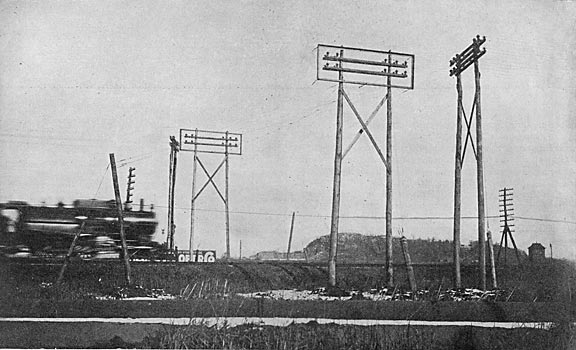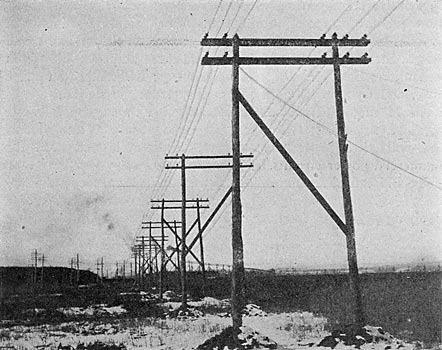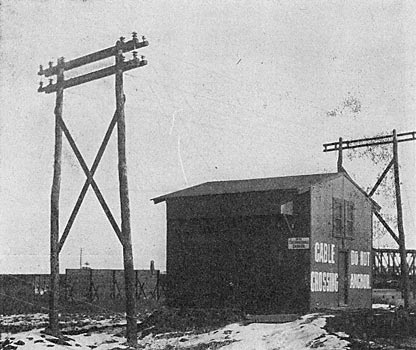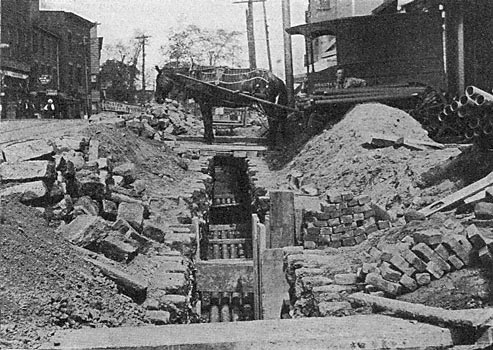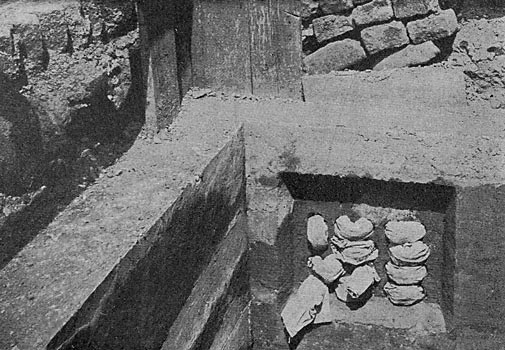[Trade Journal]
Publication: Electrical World
New York, NY, United States
vol. 47, no. 3, p. 155-158, col. 1-2
The Electrical Distribution System of the Public Service Corporation of New Jersey.—II.
BY G. U. G. HOLMAN.
THE turbine unit in the Coal Street Station in Newark is controlled in the adjacent City Dock station, the generator being classed as belonging to the City Dock station. Thus all units controlled at the Coal Street station are for the railway needs. The sub-stations are fed from this station by 13,200-volt, three-phase cables run in conduits. Central Avenue sub-station has two 1,000-kw, General Electric, 25-cycle, three-phase rotaries, two and one-half miles away from Coal Street, supplying 550 volts direct current.
Railway 550-volt current is supplied by the Coal Street station to the sub-stations at Irvington and Montclair, four miles and seven miles away, respectively. Conduits in the streets of Newark carry 13,200-volt cables to the outlying district and thence the energy is taken overhead on 70-ft. poles. The pictures in Figs. 8 and 9 show the style of conduit and manholes. Lead-covered, paper-insulated, three-conductor cables are used, laid in conduits built up of 3-in. fibre tubes, spaced 4 ˝-in centers in concrete The manholes and catch basins are rectangular in section, also of concrete. The tops are arched with railroad iron' to support the cover and traffic.
The Irvington sub-station contains one General Electric, 1,000-kw, three-phase, 25-cycle rotary and one 500-kw, General Electric, three-phase, 25-cycle rotary, both for railway 550-volt, direct-current. This sub-station contains five 17 ˝-kw, constant-current transformers used for incandescent street lighting distribution, receiving its energy from the City Dock station at 2,200 volts, 60 cycles.
| |||
| Fig. 5. — Showing Wire Cage Guard on the Sides of and Beneath the 13,000-Volt Transmission Lines at A Pennsylvania Railroad Crossing. |
Montclair sub-station contains three 500-kw, General Electric, three-phase, 25-cycle rotaries, receiving their energy from Coal Street station at 13,200 volts alternating current and supplying 550 volts direct current for railway use. In this sub-station is also 2,500 kw in General Electric, two-phase, 60-cycle, air-blast transformers, 13,200-6,600; 2,400 volts for lighting.
The City Dock station in Newark is a lighting and power station. The apparatus consists of seven Westinghouse 850-kw, 2,300-volt, two-phase, 60-cycle generators, each direct-connected to a Pennsylvania Iron Works horizontal, cross-compound, condensing engine, and one Westinghouse 500-kw, 550-volt, direct-current generator, direct-connected to a Watts-Campbell horizontal cross-compound condensing engine. There are seven 500, two 600 and four 800-hp Climax boilers at 150 lb. pressure. This station up to a year ago contained arc lighting machines that were thrown out by the present use of alternating-current arc lamps. The City Dock station, besides supplying the Irvington and the Montclair sub-stations in common with Coal Street, supplies Mechanic Street sub-station, which is solely used for power supply, and the following street lighting transformer stations: Bloomfield Avenue, two and one-half miles away; Bergen Street No. 1 and Bergen Street No. 2, 8,000 ft. apart and three and two miles from the station; East Newark, two miles away; Belleville, four miles away, and Lyndhurst, eight miles away from the station.
'I he Mechanic Street sub-station contains three 300-kw Westinghouse, 2,300-volt, two-phase and one 300-kw, Westinghouse, 2,300-volt, three-phase transformers, all 60-cycle and used for commercial power circuits.
The Bloomfield Avenue sub-station contains three General Electric, 71-kw, 6o-cycle, single-phase, 2,400-volt, tub transformers for supplying 7 1/2 amp. street arc lights.
| |||
| Fig. 6. — Transmission 13,000-Volt Lines Across the Jersey Marshes, Connecting Marion Station With Newark Plants. |
Bergen Street No. 1 and No. 2, respectively contain three and four General Electric 100-light, 2,400-volt tub transformers, supplying 7 1/2 amp. to street arc lamps. The East Newark and the Belleville sub-stations each contain three General Electric, 100-light, 7 1/2-amp., 2,400-volt tub transformers used for both arc and series incandescent street lighting. Lyndhurst sub-station contains one 17 1/2-kw, 2,200-volt, General Electric tub transformer used solely for series incandescent street lighting.
An examination of the map (Fig. 2, last issue) of the district supplied by Coal Street and the City Dock stations with both light, power and railway service, reveals the fact of the present abandonment of the generating stations at Orange and South Orange, and the installation of two sub-stations; one at Lincoln Ave., to take the Orange station load, and one at Belleville, to fill the increased requirements for railway and lighting in that section. The South Orange station's load is to be divided between the present two sub-stations at Central Ave. and at Irvington. The apparatus in the to-be-discarded Orange station consists of a line shaft belted to one horizontal, cross-compound, Watts-Campbell, high-pressure engine, and one Hewes & Phillips horizontal, cross-compound, low-pressure engine. The boilers are three 600-hp Climax, run at 140 lb. The shaft is belted to three Westinghouse generators and one General Electric generator of a total capacity of 690 kw supplying 500 volts for power and railway; two two-phase Stanley, 2,600 volts, 60-cycle, 275 kw each for lighting, and 256 kw of arc lighting generators, Brush and Thomson-Houston. As a present temporary sub-station supplied by City Dock station there are installed 6,600-volt transformers consisting of eight 100-kw, two to three-phase, 60-cycle, Wagner oil type; three 50-light, General Electric, 2,200-volt, 6.6-amp. tub transformers ; two 17 ˝-kw, General Electric tub transformers for series incandescent street lights, and three 21 ˝-kw, General Electric voltage regulators, used for series incandescent street lights.
| |||
| Fig. 7. — Aerial 13,000-Volt Transmission Line Connecting With Hackensack River Cable Within Cable Building. |
By a further examination of the map showing the Northern New Jersey distribution it will be readily seen what an important part the new Marion station will play in the more economical supply of light, power and railway energy in this section. Grand Street and Wayne Street stations, two old, small unit stations, and one sub-station (Communipaw), are to be replaced by the new sub-station (Pennsylvania) in this same district, and the present tie feeders connecting the three sets of apparatus with the Hoboken Fourteenth Street central plant will be taken out.
The Grand Street station contains nothing but railway generators of 500 volts direct current. There are six Westinghouse, 175-kw generators, each belted to Ball & Wood high-speed compound condensing engines; one General Electric 525-kw generator and two Westinghouse 375-kw generators, each direct-connected to an Allis horizontal cross-compound condensing engine. There are five Heine and six Babcock & Wilcox boilers of 250 hp each run at 125 lb.
Wayne Street is also an old plant, consisting mainly of slow-speed engines belted to a jack shaft and operating about 1,195 kw in four units at 2,600 volts of Stanley generators; 400 kw emergency railway generators of two 200-kw Westinghouse each; 620 kw of 550-volt power generators in three units, and about 1,200 kw of direct-current Brush & Wood arc lighting machines. The engines are Watts-Campbell and George H. Corliss horizontal cross-compound and two tandem compound Mackintosh & Seymour, to which some of the generators are belted direct. The boilers are three 500 and two 600-hp Climax, run at 150 lb. pressure.
Until the Marion station and the new Pennsylvania sub-station are actually in service, Wayne Street station contains also one Westinghouse 300-kw, 6,600-volt, 550-volt, 60-cycle rotary, used for power service and fed from the City Dock station at Newark through the feeder across the Hackensack meadows, built over a year ago in anticipation of future use by the new Marion plant. This tie consists of three feeders, each of three 2-0 copper, stretched across the Hackensack marshes on two cross arms sin ported by two poles, as shown in Fig: 6. Where the feeder under the Passaic and Hackensack Rivers three-conductor lead-covered, iron-armored and paper-insulated cables; are use. There are cable and lightning arrester houses; as shown in Fig. 7, on both sides of the Hackensack River and on the east side of the Passaic. Three-conductor, 2-0, lead-covered, paper-insulated cables, are run underground from the east cable hour to the Marion power house. There are also in Wayne Street eight 100-kw Wagner, oil-cooled, 6.600-2,400-volt transformers, use for commercial incandescent lighting as step-down transformer from the Newark station. The concentration of service supply for railway and lighting to the Pennsylvania sub-station and the abandonment of the comparatively uneconomical plants of Wayne Street and Grand Street will make for economy in copper and in kw-hour cost.
The discarded Communipaw sub-station contained one Westinghouse 300-kw, 6,600-volt, 60-cycle, two-phase rotary, giving 550 volts direct current for power purposes fed from Wayne Street station. The Grand Street plant, did not feed any sub-station.
Two new sub-stations, "Junction" and "Bayonne," will be fed from the Marion station and will contain rotary units of 1,000 kv for railway supply and step-down static-transformers for lighting.
The Palisade Avenue plant Iris been shut down since spring and consisted of small generators belted to jackshaft and slow-speed engines. The Palisade sub-station: temporarily fed from Coal Street and Secaucus, will be fed entirely by the Marion plant and consists of three 1,000-kw, three-phase. 25 cycle, General Electric, 13,200-volt-550-volt, direct-current rotaries for railway and two 500-kw, three and two-phase, 60-Cycle: 13.200 2,600-volt, oil Westinghouse transformers, fed from City Dock station, Newark.
The Secaucus plant is temporarily connected with four substations—Palisade Avenue, New Durham; Hackensack and Passaic—with 13,200-volt, 25-cycle energy for railway distribution. The plant contains one three-phase. 25-cycle, 13,200-volt. General Electric, 1,800-kw generator direct-connected to an horizontal compound Brown Corliss -condensing engine two three-phase, 25-cycle, 13,200-yolt General Electric 400-kw generators, each. direct-connected to an horizontal compound condensing Watts Campbell engine; three 550-volt, Westinghouse railway generators, driven by a Pennsylvania Iron Works horizontal cross-compound, condensing engine; and a 300-kw, General Electric, 13,200-volt, 25-cycle rotary. The boilers are two 500-hp and-four 250-hp Babcock & Wilcox, at 200 lb. pressure, and four 320-hp Climax at 200 lb. pressure, not at 125 lb.
The Palisade Avenue sub-station is fed also from Coal Street station and has previously been described. The New Durham sub-station contains two General Electric, 1,000-kw, 13,200-volt, 25-cycle rotaries giving 550 volts direct current. The Hackensack sub-station contains two 550-kw, General Electric, 13,200-volt; 25-cycle rotaries feeding 550 volts direct current. This sub-station can also be fed from the Marion and the Coal Street plants by way of Secaucus station and Palisade. Avenue substation, as the Secaucus bus can be tied in to the Coal Street plant. The Passaic sub-station contains one 1,000-kw and one 300-kw, General Electric, 13,200-volt, 25-cycle rotary, giving 550 volts direct-current for railway service. Passaic sub-station, feeding from Secaucus, can also be fed from the Marion and Coal Street plants. The capacity in 13,200-volt, 25-cycle generating apparatus given by the Marion station permits the shutting down of the Passaic generating plant, as the Passaic sub-station contains also step-down lighting equipment supplied from the Paterson plant as follows: Two Wagner 100-kw, 6,600-2,600-volt, two-phase, 60-cycle, oil-cooled transformers; two General. Electric transformers of like capacity and style, and one Stanley 2,000-1,000, 60-kw, single-phase, 133-cycle transformer used for incandescent street lighting.
The Paterson plant, as soon as changes can be made, will naturally go the way of small unit plants, but cannot be spared for some time to come. It contains many small units as follows: One pair of 100-kw and four pairs of 200-kw, General Electric, 135-volt, direct-current generators, feeding a direct-current incandescent service, and four pairs of 225-kw, 550-volt, direct-current and one pair of 235-volt, direct-current generators for railway supply. Each of the ten pairs of the foregoing sets is direct-connected to a vertical Ball & Wood condensing engine. Two vertical Ball & Wood condensing engines drive a line shaft to which is belted three 100-kw, General Electric, 500-volt, direct-current generators for railway service; one 150-kw, 1,200-volt and one 300-kw, 2,400-volt, Stanley, two-phase, 133-cycle generators, and twelve Brush arc generators of 100 lights each. The boilers are ten 500-hp Stirling at 160 lb. pressure. Three 100-kw, Wagner, 60-cycle, 6,600-2,400-volt, and two 100-kw, one, two and three-phase, 60-cycle, 6,600-2,400-volt, General Electric transformers are in use, stepping up to the 6,600-volt line to the Passaic substation.
| |||
| Fig. 8. — Duct Construction, Streets of Newark. |
The Hackensack plant consists of two Stanley inductor type, 1,000-kw, 2,500-volt, 66-cycle, two-phase generators, and one Stanley, 825-kw, 66-cycle, two-phase generator, each direct-connected to a vertical cross-compound Mackintosh & Seymour condensing engine. There are four 300-hp Stirling and two Hogan water-tube, 350-hp boilers at 150 lb. pressure. This station will be shut down and at present has as sub-station apparatus eight General Electric Company 100-kw, 60-cycle, 2,200-6,600-volt transformers, one pair as a spare unit and each of the other pairs supplying the present lighting sub-station at Rutherford (which will be abandoned), and Englewood and Ridgewood. The lines for the eastern section of this territory are cabled under the Hackensack River in submarine cables. Cable houses supplied with cable switchboards are at the points where the cables enter and leave the river. As extra cables are laid, damaged cables can be readily cut out and perfect ones cut in. The cable house switches make it convenient for the testing of grounds. The transmission line to Ridgewood is eleven miles in length, the Rutherford line six miles and the Englewood line seven miles.
The Ridgewood sub-station contains three 75-kw, General Electric, single-phase, 60-cycle, 6,600-2,200-volt transformers, one being a spare. Commercial lighting and street series incandescent circuits are fed over a wide suburban district. The Rutherford sub-station contains five 75-kw, General Electric, single-phase, 60-cycle, 6,600-2,200-volt transformers, one being a spare. They supply commercial and incandescent street lighting. Two General Electric tub transformers of 14 kw each supply series arc lights. The Englewood sub-station contains three Stanley, 6,600- 2,200-volt, 60-cycle, 50-kw transformers and one General Electric of like capacity and type, which with one Stanley transformer is reserved as a spare unit. There are also two General Electric, 30-kw, 6,600-3,000-volt, tub transformers for arc street lighting. These three sub-stations will be fed from the Marion plant and a new sub-station called the Hudson River is to be erected part way between Englewood and New Durham, which will give a better distribution of circuits.
| |||
| Fig. 9. — Concrete Manhole Construction. |
The Hoboken plant at Fourteenth Street and the Hudson River will be retained, as all its capacity is required in the immediate vicinity. The district is rich in possibilities for power distribution. The present tie line with Jersey City at the Wayne Street station is to be dispensed with and the Hoboken plant relieved of this portion of its load, will permit the plant to better care for its own requirements for several years to come. The plant contains three Stanley inductor, type, 750-kw, 60-cycle, two-phase, 2,600-volt generators. Two are direct-connected, each to a Providence Corliss cross-compound, horizontal, condensing engine, and one to a Pennsylvania Iron Works cross-compound, horizontal, condensing engine. There are three 850-kw, direct-current, General Electric, 550-volt generators, each direct-connected, to a Pennsylvania. Iron Works cross-compound condensing engine. There is one Westinghouse 3oo-kw, 2,600-volt, two-phase, 6o-cicle rotary, giving 56o volts for power work. Four alternating-current Stanley, two-phase induction motors of 200 kw each are connected on the same shaft with a pair of Brush 100-light, alternating-current arc machines. There are eight 520-hp Babcock & Wilcox boilers at 150 lb. pressure.
There are two small independent plants in this Northern New Jersey section which are planned to remain owing to the difficulty in securing right of way for the necessary high-tension pole line. These are Morristown and Boonton, each situated about sixteen miles in an air line from the nearest central station at Newark, and about eight miles from each other. Both are lighting plants. Morristown contains two 120-kw and two 150-kw General Electric. 60-cycle, single-phase, 1,100-volt generators, belted to three Ball & Wood cross-compound, non-condensing engines. There are three 250-hp Hazelton, vertical tubular boilers at 130 lb. pressure. At the Boonton station are two Stanley 90-kw, 1,200-volt, two-phase, 60-cycle generators, each belted to a Ball & Wood simple non-condensing engine. There are two Bigelow horizontal boilers of 125 hp each at 100 lb. pressure.
The Elizabeth plant is six miles from Newark and contains two Genera, Electric 525-kw, 550-volt, direct-current railway generators, both direct-connected, one to a Watts-Campbell and the other to a Providence Corliss horizontal cross-compound condensing engine. There is also one 120-kw and two 300-kw, one, two and three-phase, 60-cycle, General Electric, 2,300-volt generator, belted to a line shaft; one 225-kw, General Electric, 550-volt, direct-current railway generator, also belted to the line shaft and sometimes used as a motor to drive the line shaft; two 25-kw and two 45-kw Edison bipolar generators, 525 volts, belted to the line shaft, and about 225 kw of Brush and Thomson-Houston arc machines belted to this same line shaft. This shaft is driven by a 400-hp Pennsylvania Iron Works, horizontal, compound condensing engine. This station also contains four Wagner, 6,600-2,400-volt, single-phase, 6o-cycle, self-cooled, 250-kw transformers, used for stepping down from the City Dock station, Newark. There are also two Stanley, 25-kw, 2,400-500-volt, single-phase, 6o-cycle, transformers used for a teaser connection. The boiler capacity consists of six 250-hp Babcock & Wilcox boilers and two 550-hp horizontal tubular Stewart boilers, all at 550 lb. pressure.
The Elizabeth plant is having a tie line installed connecting with the Rahway sub-station and through this to the Metuchen plant. The Cranford plant is wholly for, railway supply, is about 4% miles from Elizabeth and contains two Westinghouse 800-kw, 600-volt generators, direct-connected to a Williams, vertical cross-compound condensing engine. There are nine 150-hp horizontal tubular Stewart boilers at 560 lb. pressure.
There is a 600-amp. storage battery at Orange for railway feed built by the National Storage Battery Company, one at Paterson of 700 amp. capacity, built by the Electric Storage Battery Company, used to supplement direct-current incandescent lighting, and a power battery of 500 volts of 5,000 amp. capacity, at Mechanic Street.

